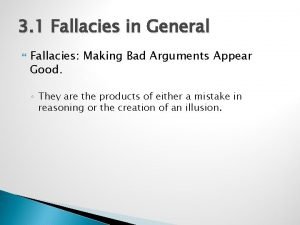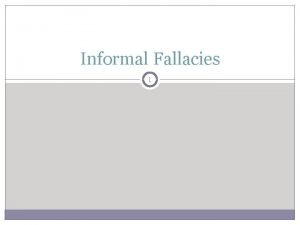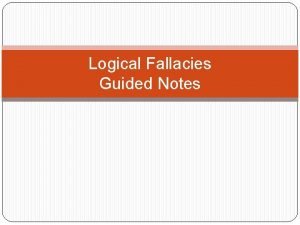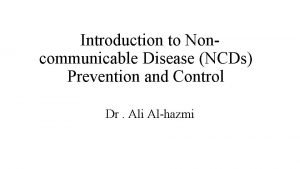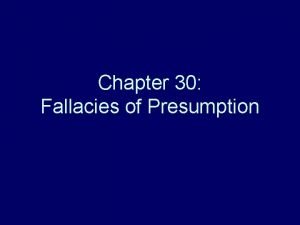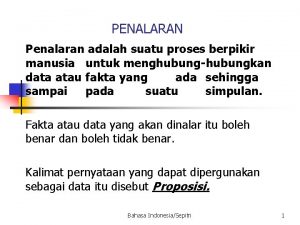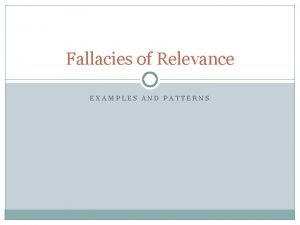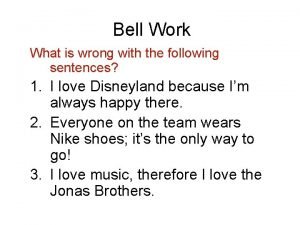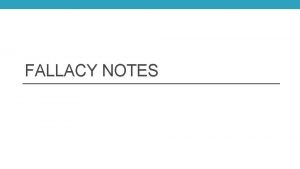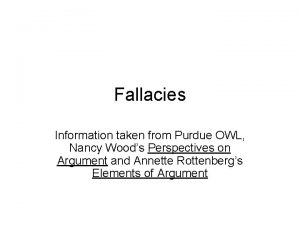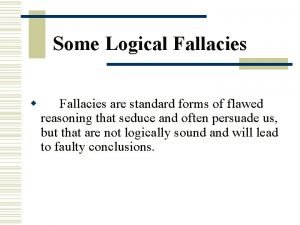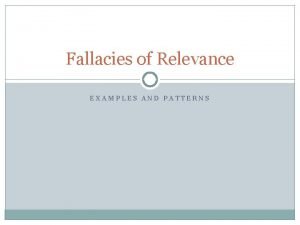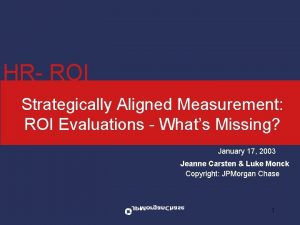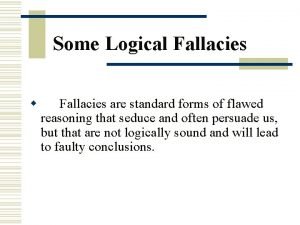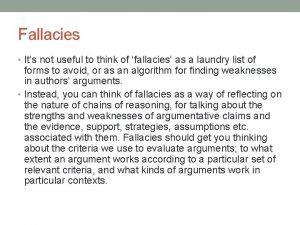ROI measurement Finding the Fallacies ROI How ROI










































- Slides: 42

ROI measurement: Finding the Fallacies

ROI • How ROI is calculated • Some examples of what ROIs are • How to know when it is calculated wrong, as it usually is – Best way to understand ROI is to spot examples of how it is calculated wrong • Like learning to drive by getting behind the wheel rather than watching someone else

ROI • Take the total population with the disease • Trend it forward by the plan’s inflation rate • That gives you the “adjusted baseline. ”

ROI • • Take the total population with the disease Trend it forward by the plan’s inflation rate That gives you the “adjusted baseline. ” Calculate the actual spending on that disease and compare it to the adjusted baseline

ROI • • Take the total population with the disease Trend it forward by the plan’s inflation rate That gives you the “adjusted baseline. ” Calculate the actual spending on that disease and compare it to the adjusted baseline • TOTAL savings on claims/TOTAL fees = ROI* • Savings are usually calculated wrong

* • Total savings/total fees = ROI • Total savings – total fees = net savings • Example: – Program cost $100 – Program savings $400 – ROI is 4: 1 – Net savings is $300

In pre-post • You find everyone in the baseline year(s) with claims for the disease • You develop a baseline year cost/disease person • You trend that cost forward and compare the “actual” cost for the disease-managed population • Example: Asthma

In the example • Assume no inflation, no claims other than asthma – These assumptions just simplify. They don’t distort

Example from Asthma First asthmatic has a claim in 2004 Asthmatic #1 Asthmatic #2 Cost/asthm atic 2004 (baseline) 2005 (contract) 1000 0

Example from Asthma Second asthmatic has a claim in 2005 2004 (baseline) 2005 (contract) Asthmatic #1 1000 0 Asthmatic #2 0 1000 Cost/asthm atic

Question • What is your cost/asthmatic during the baseline year?

Cost/asthmatic in baseline? 2004 (baseline) 2005 (contract) Asthmatic #1 1000 0 Asthmatic #2 0 1000 Cost/asthm atic

Cost/asthmatic in baseline? 2004 (baseline) 2005 (contract) Asthmatic #1 1000 0 Asthmatic #2 0 1000 Cost/ asthmatic $1000

In pre-post – remember this slide? • You find everyone in the baseline year(s) with claims for the disease • You develop a baseline year cost/disease person • You trend that cost forward and compare the “actual” cost for the disease-managed population • Example: Asthma

Cost/asthmatic in contract period? 2004 (baseline) 2005 (contract) Asthmatic #1 1000 0 Asthmatic #2 0 1000 Cost/ asthmatic $1000

Cost/asthmatic in contract period? 2004 (baseline) 2005 (contract) Asthmatic #1 1000 0 Asthmatic #2 0 1000 Cost/asthm $1000 atic $500

Congratulations • You just “saved” 50% by doing nothing • This is called the “zeroes” or “planes on the ground” fallacy (planes on the ground aren’t spotted by radar) – The claims extraction methodology only works if someone with the disease has disease-specific claims in the baseline year • Note that the way you can spot this fallacy is that prevalence rises dramatically, reductions in cost bears no resemblance to quality improvements, and claims fall without any “nexus” to the program

ROI By Disease: Impact of the fallacy

Examples of invalid calculations • ROI mistake #1: Let’s go to the web…

ROI Mistake #2 • In the following example, utilization figures were multiplied by the (assume to be correct) cost figures to get a savings • Assume (correctly) no other changes were talking place • Why is this obviously incorrect?

Savings by Category of Utilization per 1000 members

Issue-spotter #3 Can you critically analyze these presented numbers from a major national health plan? * Disease Category Asthma Admission Reduction 2% Cost Reduction cardiology 5% 12% *The name of this health plan will not be provided – you had to be there

Asthma Emergency Room Visits Issue-Spotter #4: What is wrong with this slide Total N = 781 High Risk N = 61 Low Risk N = 720 Note: name of vendor can be shared upon NDA

Issue-Spotter #5 • Look at the next two slides together

Asthma Hospital Admissions 13% 57% 63%

Asthma Hospital Days Total N = 781 High Risk N = 61 Low Risk N = 720 -70% -48% -43%

Asthma Hospital Days and Admissions DAYS ADMISSIONS -70% -48% -43%

Issue-Spotter #6 • Look at the next two slides together

Care to try your luck at this one? CHF Group #1 Emergency Room Visits/Year Total N = 1166 High Risk N = 268 Low Risk N = 898

Care to try your luck at this one vs. the other one? CHF Group #1 Inpatient Admissions/Year Total N = 1166 High Risk N = 268 Low Risk N = 898

Care to try your luck at this one? Emergency Room Visits and IP stays/Year ER Visits IP Stays

Issue-Spotter #7 • Can you find the mistake which a major actuarial firm missed?

Pre-post comparison: Asthma Medicaid Disabled Population Membermonths Cost PDMPM Gross savings & ROI Baseline Period 1/0312/03 paid through 6/30/04 Study Period 1/0412/04, paid through 2/28/05 15047 31884 $432 $391 $2, 400, 125 2. 72 – to -1

Issue Spotter #8 • What do you see in these two slides? – Within either, or comparing the two? – This was presented by Blue Cross of Minnesota

Cohort Study Results (all claims, all members)

ROI and PMPM reductions at 6 Months • Reporting Period – July - December 2002 • Base Period – July - December 2001 • Total ROI 2. 48 : 1 – Extended Conditions 4. 23 : 1 – Core Conditions 1. 86 : 1 • “Our Auditors validated a $42 PMPM reduction due to this program”

Combined • Reporting Period – July - Dec 2002 • Base Period – July - Dec 2001 • Total ROI 2. 48 : 1 – Extended Conditions 4. 23 : 1 – Core Conditions 1. 86 : 1 • Auditors validated a $42 PMPM savings

#9 – What’s wrong with these outcomes?

Program Year One – Clinical Indicators Clinical Outcomes:

Issue-Spotter #10 • What kills the credibility of the savings reported on the next slide?

Top Ten Diagnoses—admissions per 100 Cardio Disease Management Members (pre- and post-DM)

Conclusion • Don’t assume that it’s right just because it’s written down • 75% of reporting has major, invalidating mistakes in it • Who feels better equipped to look for them?
 Tạo đặc điểm và thiết kế trang phục rối
Tạo đặc điểm và thiết kế trang phục rối Thou shalt not commit logical fallacies
Thou shalt not commit logical fallacies Amphiboly fallacy examples
Amphiboly fallacy examples Fallacies breaking bad
Fallacies breaking bad Fallacy of missing the point
Fallacy of missing the point Accident fallacy
Accident fallacy Lexicons
Lexicons Texas sharpshooter fallacy
Texas sharpshooter fallacy Fallacy of illicit transference
Fallacy of illicit transference Hasty generalization definition
Hasty generalization definition Appeal to vanity fallacy
Appeal to vanity fallacy Fallacies in the crucible
Fallacies in the crucible Myths and fallacies about non communicable diseases
Myths and fallacies about non communicable diseases Fallacies of presumption
Fallacies of presumption Logical fallacies in thank you for smoking
Logical fallacies in thank you for smoking Example of fallacies of ambiguity
Example of fallacies of ambiguity Purdue owl logical fallacies
Purdue owl logical fallacies Plain folks propaganda in animal farm
Plain folks propaganda in animal farm Logical fallacies
Logical fallacies Exegetical fallacies
Exegetical fallacies Logical fallacies
Logical fallacies Logical fallacies detector
Logical fallacies detector Fallacies in academic writing
Fallacies in academic writing Rhetorical devices vs logical fallacies
Rhetorical devices vs logical fallacies Fallacies of ambiguity
Fallacies of ambiguity Logical fallacies
Logical fallacies Fallacies of ambiguity
Fallacies of ambiguity False equivalence fallacy
False equivalence fallacy Example of attacking the motive fallacy
Example of attacking the motive fallacy Fallacies of omission
Fallacies of omission Is ethos a logical fallacy
Is ethos a logical fallacy False dilemma
False dilemma Logical fallacies bell ringer journal
Logical fallacies bell ringer journal Fallacy of accident
Fallacy of accident Hasty generalization fallacy
Hasty generalization fallacy What is logical fallacy
What is logical fallacy Owl logical fallacies
Owl logical fallacies Fallacy of weak induction
Fallacy of weak induction Dogmatism fallacy definition
Dogmatism fallacy definition Slippery fallacy
Slippery fallacy Example of relevance
Example of relevance Các loại đột biến cấu trúc nhiễm sắc thể
Các loại đột biến cấu trúc nhiễm sắc thể Lời thề hippocrates
Lời thề hippocrates



